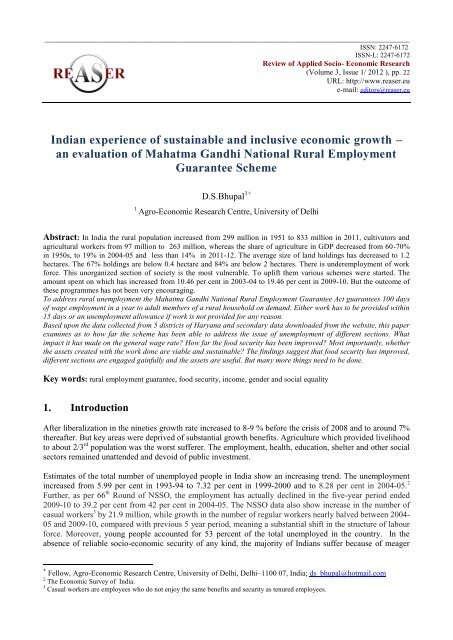Volume 3, ISSUE1/2012 - Review of Applied Socio-Economic ...
Volume 3, ISSUE1/2012 - Review of Applied Socio-Economic ...
Volume 3, ISSUE1/2012 - Review of Applied Socio-Economic ...
You also want an ePaper? Increase the reach of your titles
YUMPU automatically turns print PDFs into web optimized ePapers that Google loves.
________________________________________________________________________________________________<br />
ISSN: 2247-6172<br />
ISSN-L: 2247-6172<br />
<strong>Review</strong> <strong>of</strong> <strong>Applied</strong> <strong>Socio</strong>- <strong>Economic</strong> Research<br />
(<strong>Volume</strong> 3, Issue 1/ <strong>2012</strong> ), pp. 22<br />
URL: http://www.reaser.eu<br />
e-mail: editors@reaser.eu<br />
Indian experience <strong>of</strong> sustainable and inclusive economic growth –<br />
an evaluation <strong>of</strong> Mahatma Gandhi National Rural Employment<br />
Guarantee Scheme<br />
D.S.Bhupal 1+<br />
1 Agro-<strong>Economic</strong> Research Centre, University <strong>of</strong> Delhi<br />
Abstract: In India the rural population increased from 299 million in 1951 to 833 million in 2011, cultivators and<br />
agricultural workers from 97 million to 263 million, whereas the share <strong>of</strong> agriculture in GDP decreased from 60-70%<br />
in 1950s, to 19% in 2004-05 and less than 14% in 2011-12. The average size <strong>of</strong> land holdings has decreased to 1.2<br />
hectares. The 67% holdings are below 0.4 hectare and 84% are below 2 hectares. There is underemployment <strong>of</strong> work<br />
force. This unorganized section <strong>of</strong> society is the most vulnerable. To uplift them various schemes were started. The<br />
amount spent on which has increased from 10.46 per cent in 2003-04 to 19.46 per cent in 2009-10. But the outcome <strong>of</strong><br />
these programmes has not been very encouraging.<br />
To address rural unemployment the Mahatma Gandhi National Rural Employment Guarantee Act guarantees 100 days<br />
<strong>of</strong> wage employment in a year to adult members <strong>of</strong> a rural household on demand. Either work has to be provided within<br />
15 days or an unemployment allowance if work is not provided for any reason.<br />
Based upon the data collected from 5 districts <strong>of</strong> Haryana and secondary data downloaded from the website, this paper<br />
examines as to how far the scheme has been able to address the issue <strong>of</strong> unemployment <strong>of</strong> different sections. What<br />
impact it has made on the general wage rate? How far the food security has been improved? Most importantly, whether<br />
the assets created with the work done are viable and sustainable? The findings suggest that food security has improved,<br />
different sections are engaged gainfully and the assets are useful. But many more things need to be done.<br />
Key words: rural employment guarantee, food security, income, gender and social equality<br />
1. Introduction<br />
After liberalization in the nineties growth rate increased to 8-9 % before the crisis <strong>of</strong> 2008 and to around 7%<br />
thereafter. But key areas were deprived <strong>of</strong> substantial growth benefits. Agriculture which provided livelihood<br />
to about 2/3 rd population was the worst sufferer. The employment, health, education, shelter and other social<br />
sectors remained unattended and devoid <strong>of</strong> public investment.<br />
Estimates <strong>of</strong> the total number <strong>of</strong> unemployed people in India show an increasing trend. The unemployment<br />
increased from 5.99 per cent in 1993-94 to 7.32 per cent in 1999-2000 and to 8.28 per cent in 2004-05. 2<br />
Further, as per 66 th Round <strong>of</strong> NSSO, the employment has actually declined in the five-year period ended<br />
2009-10 to 39.2 per cent from 42 per cent in 2004-05. The NSSO data also show increase in the number <strong>of</strong><br />
casual workers 3 by 21.9 million, while growth in the number <strong>of</strong> regular workers nearly halved between 2004-<br />
05 and 2009-10, compared with previous 5 year period, meaning a substantial shift in the structure <strong>of</strong> labour<br />
force. Moreover, young people accounted for 53 percent <strong>of</strong> the total unemployed in the country. In the<br />
absence <strong>of</strong> reliable socio-economic security <strong>of</strong> any kind, the majority <strong>of</strong> Indians suffer because <strong>of</strong> meager<br />
+ Fellow, Agro-<strong>Economic</strong> Research Centre, University <strong>of</strong> Delhi, Delhi–1100 07, India; ds_bhupal@hotmail.com<br />
2 The <strong>Economic</strong> Survey <strong>of</strong> India.<br />
3 Casual workers are employees who do not enjoy the same benefits and security as tenured employees.








